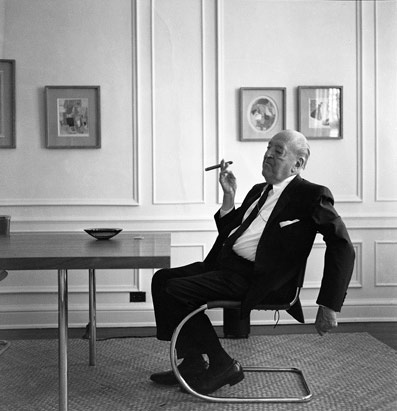
Interior of a 1958 Subaru 360.
You’re reading Signal v. Noise, a publication about the web by Basecamp since 1999. Happy !
Jason co-founded Basecamp back in 1999. He also co-authored REWORK, the New York Times bestselling book on running a "right-sized" business. Co-founded, co-authored... Can he do anything on his own?

Interior of a 1958 Subaru 360.

Great shot of Mies. Photo by Werner Blaser.

This antique Skippy Racer is absolutely beautiful.
I recently acquired an old farm house in rural southwestern Wisconsin. I’ve always wanted a place out in the country. With the real estate market taking a hit I figured this was a good time to buy. Time will tell on the financial return, but the peacefulness return is already paying off.
However, it’s not all about relaxation — I do want to work from there from time to time. Foolishly I assumed that broadband was just about everywhere now, but it’s not. If you’re a mile off the highway, or not in a town of thousands, you may be stuck in the 90s.
First I checked into DSL. Verizon provides it in the nearby town which is a few miles away. But the central office is too far from my house so it’s a no go at this time.
Then I checked with the local cable company. There aren’t cable lines in the area so that’s not an option either. No cable TV and no cable internet.
I discovered an interesting option from a neighbor over the hill (land, not age). He uses a wireless service. He has a dish-like-thing on his roof and he has a line of sight view to one of about a dozen towers in a 30 mile radius. The speeds are multi-megabit up and down, there are no transfer limits, and it’s about $40/month. It’s a pretty sweet service. Unfortunately (from an internet service perspective) my property is stuck in a valley so I don’t have line of sight to any towers. They even tried climbing this old windmill on a hill, but it can’t see any of the towers either. So that’s a no go.
I have a Sprint 3G EVDO card which is wonderful when I’m on the road in big cities, but there’s no 3G out where I’ll be. I do get EDGE out there, and the card can handle that, so I can get access but it’s very slow. At least it works. I checked Verizon, AT&T, T-Mobile, and US Cellular, but no one has 3G out there. US Cellular has the best cell coverage, but it’s EDGE-speeds at best. US Cellular does say they are rolling out a 3G network starting early next year.
I don’t even know if this is an option, but I fear if it is it’s going to be hundreds or thousands to install and hundreds a month. Not an option for a sometimes house.
It appears the only way to go is satellite. That means the horribly reviewed HughesNet. Terrible customer service, satellite latency (who knew the speed of light wouldn’t be fast enough), 2-year contracts, hardware and fees, and draconian download limits (200 MB/day or they throttle you way down).
Is anyone out there using HughesNet? I know message boards and forums are usually filled with the worst of the worst complaints, so any personal experiences with this service would be useful, thanks.
Please tell me someone has a really creative solution here. Is there something I haven’t thought of? Any geniuses out there with an answer? I’m afraid I may have exhausted my options beyond satellite. So satellite it may have to be, but I’m hoping there’s another way.
For a while we’ve been exploring switching to WYSIWYG text editing in our products. Up until this point we’ve been using either plain text, manual HTML, or Textile formatting. Depending on who you are it’s either fine or annoying. We want to do a lot better.
We’ve looked at a lot of existing options (Yahoo’s WYSIWYG plug-in, TinyMCE, etc), but we weren’t happy with any of them. Currently available WYSIWYG editors don’t offer much flexibility when it comes to modifying their look and behavior. You are stuck with their HTML, buttons, and design. Modification was possible, but it was really ugly behind the scenes. We really needed a framework for building our own editor with beautiful code and a low cost of change.
So we decided to make our own. It’s called WysiHat and we’ve open sourced it. Get it? WysiHat. Hat instead of Wig? Funny, we know! Today we’re releasing a very stripped down early developer release.
WysiHat is a WYSIWYG JavaScript framework that provides an extensible foundation to design your own rich text editor. WysiHat stays out of your way and leaves the UI design to you. Although WysiHat lets you get up and running with a few lines of code, the focus is on letting you customize it.
We are giving developers early access to the project while we continue to work out the remaining issues. Note: It’s extremely early. Contributors are welcome so please check out the project on GitHub and send us your feedback.
From the Business of Software conference in Boston, September 2008.
Today we officially announced a big new Highrise feature called Deals. Deals lets you keep track of proposals, bids, and estimates you’re submitted, won, or lost.
This new feature is especially handy for designers, developers, contractors who bid on projects for clients. Now you’ll know which proposals are still out for bid, when you sent them, who you’re expecting to hear back from, which ones you won, which ones you’ve lost, and how much money you’ve made from each customer.
I wish I had Highrise Deals when we were doing website design. I had a hard time remembering all the RFPs we’d responded to and how many projects we’d won or lost and why we’d won or lost them. Saying I was disorganized would be kind.
The best way to get a feel for the new feature is to watch a video demo:
(See a bigger, clearer version on the Product Blog)
If you don’t have a Highrise account, sign up today. If you do, we hope you find Deals useful! Thanks again for your continued support.

A couple months ago I posted “Sour Apple: How an Apple ad sets the wrong expectations” here on SvN.
I felt that the interface response time and network transfer rate was unrealistically fast. It looked like they had to cut out a bunch of frames to make things as fast as they were advertising. I felt that was deceitful without claiming that the sequence was simulated or shortened in some way.
Yesterday I noticed they are now adding some fine print to the bottom of some of their ads that says “Sequence shortened” (the red box above is mine for emphasis).
It’s good to see them adding the disclaimer to these ads. The fine print doesn’t distract from the ads in any way. I think it’s a win-win.
This year I’ve spoken at about a dozen or so conferences and another dozen or so meetings or classes or gatherings.
What I’ve started to notice is that I’m better unprepared.
That doesn’t mean I go in without any idea of what I’m going to talk about. And it doesn’t mean I may not have some slides to support the ideas (although lately I’ve been speaking slide-free). But it does mean that I’ve stopped practicing.
This year I spoke at the Web 2.0 Expo in New York. I gave two talks — an hour talk on “The Things We’ve Learned at 37signals” in front of a few hundred people and a 15 minute keynote about “Software Curators” in front of a couple thousand.
I’ve sorta given the Things We’ve Learned talk before, but it had been many months. I didn’t practice at all. I had some slides prepared that I’d used before, but I didn’t review them prior to going on.
I’d never given the Software Curator talk before, so I practiced and practiced and practiced the night before. I was manic about it. I ran through it a few dozen times.
When it came time to give the “Things We’ve Learned” talk I was relaxed. I looked at the slides with everyone else and I just said what came to mind. I think it was one of my better talks.
When it came time to give the “Software Curator” talk, I was nervous. Not because I was speaking in front of a couple thousand people, but because I kept thinking about what I was supposed to say based on hours of practice. I kept reliving the practice, not living the moment. I keep reaching for the script in my mind instead of my current thoughts. I wasn’t happy with the talk at all.
Continued…